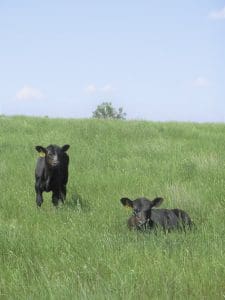By Patti Wilson, Contributing Editor
Some of the most persistent and brutal diseases on earth seem to be those that have been with us since the beginning of recorded history. Rabies and malaria are examples of stubborn pestilence that refuse to go away. Another malady we continue to battle is tetanus. Nearly every mammal is susceptible, and every livestock producer needs to manage for it.
I am betting that our readership first learned the word tetanus from our mothers. “Don’t step on a nail,” they warned as we headed out the door, barefoot, on a hot summer day. “You’ll get tetanus!”
Because of improved health care in the United States, vaccinations have become routine. Thankfully, they are effective. So much so that many of us now take this deadly disease for granted. Our livestock are not always as well served.
A brief history
According to the National Vaccine Information Center, the first clinical description of tetanus dates back to records from the fifth century BC. It was 1884, however, before legitimate scientific experiments were able to isolate the disease and study it.
Initially, important discoveries about tetanus were made in Italy and Germany. In 1889, a Japanese bacteriologist determined that it could grow only in anaerobic (no oxygen) conditions and confirmed its ability to affect various species of mammals. By 1900, pharmaceutical companies began developing antitoxins against tetanus. They were largely produced in horses, who were bled to harvest their blood serum.
A fortunate circumstance grew from the timing of these discoveries; the antitoxin serum was widely used on injured soldiers in World War I. Ground troops suffered wet, unsanitary conditions in trench warfare. Shrapnel wounds were a common injury and conducive to the tetanus bacteria. Military physicians began to use the antitoxins freely, even experimenting with its use in varying strengths and number of doses to help prevent and overcome tetanus in the battlefield. As a result, many soldiers suffered from serum sickness and allergic reactions from the antiserums. An effective vaccine, tetanus toxoid (TT), was not available until 1938.
Tetanus vaccination programs in the United States have reduced reported tetanus cases from 601 in 1948 to just 20 in 2018.
Across the species
There are several items to note in the characteristics of tetanus. The most susceptible individuals to contract the painful disease are humans, horses and lambs. Cattle follow closely behind, with higher incidences in warmer climates. Our cats and dogs do better, they are somewhat immune, while birds are not affected.
The bacterial spores Clostridium tetani prefer living in cultivated soil and intestinal tracts, and are closely related to the clostridial bacteria causing blackleg. Tetanus spores are highly resistant to heat and disinfectants, making them impossible to eradicate.
Puncture wounds are a perfect route for the spores to take hold, especially when a small particle of soil or foreign matter is left. Sheep and cattle suffer additional risk through banding, docking and castration. Likewise, calving cows run risks when giving birth in dirty lots or when unclean equipment is used to pull calves.
The Mayo Clinic website states that gunshot wounds are a risk factor in contracting tetanus. It seems, however, if one is shot, that individual has better things to worry about than tetanus bacteria.
What does it look like?
Incubation for tetanus varies from three days to several months, but usually a couple weeks. Research and information on this matter vary widely.
Although all tetanus victims will exhibit similar symptoms, horses and cattle will have most similarity in clinical observation. Both will assume a “rocking horse” stance, according to the Merck Veterinary Manual. There will be erect stiffness of ears and tails, along with sweating. In later stages, when animals are startled, they may move with a stiff-legged goose step. This is an unmistakable symptom of tetanus in cattle. Common among all species are the neck and head spasms, which prevents the jaw and mouth from opening, hence the moniker “lockjaw.” Excessive salivation occurs at this point and treatment is useless.
The cause of these gruesome symptoms is neurotoxins produced by the bacteria in injured (necrotic) tissue that are absorbed by the motor nerves and travel up the nerve tract to the spinal cord. This is where the real trouble sets in. Severe spasmodic contractions seize the voluntary muscles. Increased toxins released into the victim’s bloodstream compound the symptoms.
Muscular contractions become so severe that they can fracture bones. Eventually, spasms affecting the larynx, diaphragm and intercostal muscles will cause respiratory failure. The toxins will also cause extreme anxiety, heart arrhythmia, crushing of the trachea and hypertension.
Depending on the source of information, mortality may reach 50-80 percent. Those affected with milder cases can recover over a period of many weeks with the aid of the antitoxin, sedatives and exceptional care. Above all, treatment must begin early in the onset of symptoms.
Prevention
When castrating with a knife, be sure the scrotal sack can drain. Turning calves back on pasture afterward is particularly helpful as well as castrating or banding before 90 days of age. Smaller sacks heal faster than large ones, offering the bacteria less time to reproduce.
Above all, vaccination is imperative, along with keeping knives, calf pullers and needles clean.
More about humans
Nearly all people born in the United States are vaccinated for tetanus. Incidence of this tragic illness is almost completely confined to underdeveloped countries. Symptoms and complications include broken bones, painful spasms, arched back, lockjaw, heart and lung blockage, and frequent death. Interestingly, according to the History of Vaccines, minor wounds are more troublesome than major ones because larger wounds are more likely to be thoroughly cleaned and tended by a physician.
One of the largest contributing factors to human tetanus cases is unsanitary conditions during childbirth. This leads to the most brutal form of the disease – neonatal tetanus – affecting newborn infants. Mortality is 100 percent.
What’s the lesson? Vaccinate your livestock, your children and yourself. The tetanus bacterium does not discriminate.





